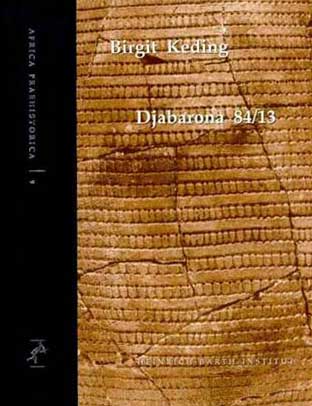
Africa Praehistorica 9, Köln 1996
Birgit Keding:
DJABARONA 84/13 – UNTERSUCHUNGEN ZUR BESIEDLUNGSGESCHICHTE DES WADI HOWAR
ANHAND DER KERAMIK DES 3. UND 2. JAHRTAUSENDS V. CHR.
(Analysis of the settlement history of the Wadi Howar on the basis
of the pottery of the 3rd and 2nd millennia BC).
- 371 pp.
- 83 figures
- 10 bw. photographs, 1colour photograph
- 46 tables, 78 plates
- English and French summaries
- hardcover, half linen-bound, size 21 x 28 cm
ISBN 3-927688-14-2
With a length of more than 1,000 km the Wadi Howar is a west-east oriented
valley system situated on the southern border of the Libyan Desert. It
was once the largest tributary of the river Nile and, until two thousand
years ago, was characterized by stretches of both running and standing
water. Over several millennia, the Wadi Howar was an ecologically favourable
area for human settlement and a highly important communication route between
the Nile Valley and the inner regions of Africa. Evidence of this is given
by numerous prehistoric sites located along the wadi banks which are particularly
characterized by pottery. Although these sites were already mentioned
by early explorers such as Newbold, Shaw and Frobenius, a systematic archaeological
investigation of this still almost inaccessible region only began with
the work of the Cologne project “Settlement History of the Eastern Sahara”
(funded by: "Deutsche Forschungsgemeinschaft") in the 1980's.
The analysis of this work was primarily based on pottery assemblages from
the Djabarona 84/13 site, the most prominent site in the region due to
its size and large quantities of finds. Its features, in particular over
1,000 undisturbed pit inventories with abundant pottery material and animal
bones, furnished an excellent basis for the analysis. Seriations, mappings
of the distribution of the pit contents as well as regional and supraregional
comparisons of absolutely dated archaeological finds, all helped establish
a chronological sequence for the use of the pits and the typological pottery
development in the 3rd and 2nd millennia BC. The results of this analysis
seem to indicate that the cattle-keepers who settled in the Wadi Howar
probably originated in the Sudanese Nile Valley but that – contrary to
previous assumptions – there was an increasing orientation towards the
adjacent areas to the west, especially in the later phases of advancing
aridity. However, not only the chronological subdivisions of the pottery
but also the archaeozoological results and the economic and probably ritual
structures that can be deduced from this analysis make Djabarona 84/13
a cornerstone for the understanding of the settlement history of the southern
Eastern Sahara.